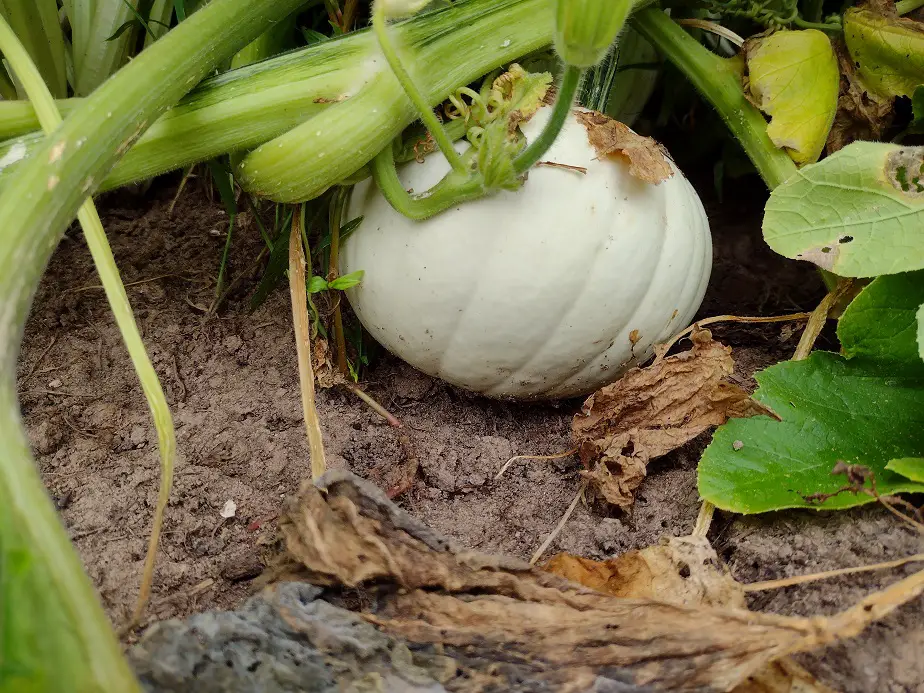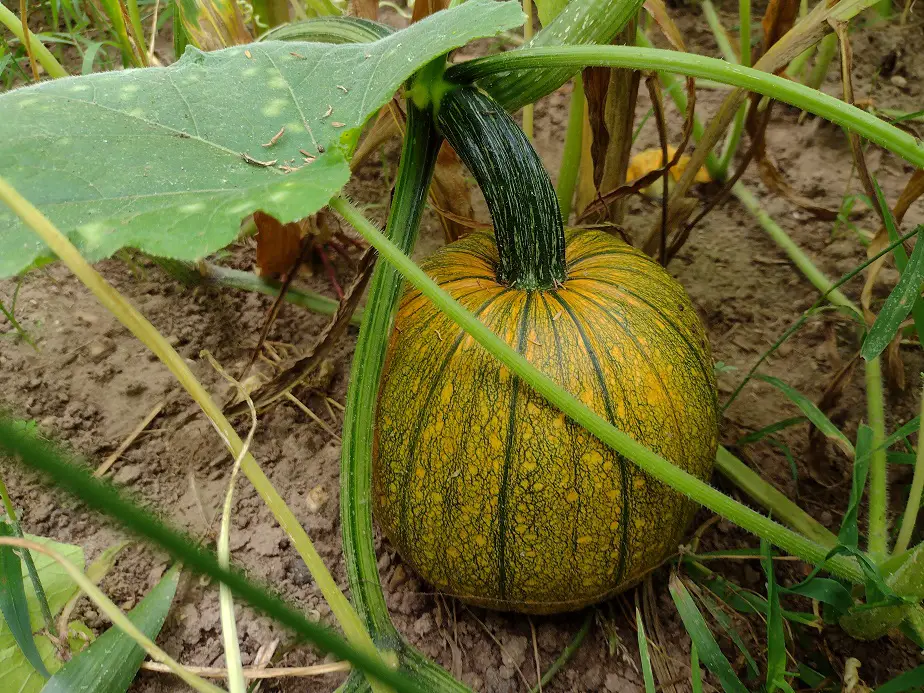Pumpkins are one of the more reliable food crops you can grow here in Michigan. We grow pumpkins every year in west Michigan for food and livestock fodder.
In Michigan, pumpkins are planted from May 23 to July 10 for a summer or fall harvest. You can plant them as soon as the soil warms up to 60 degrees and the threat of frost has passed. Most pumpkins can be plated in early June and harvested in early October for fall decoration.
Growing pumpkins is fairly straightforward, but there are a few big issues you may have to overcome to do it successfully.
Planting Pumpkins in Michigan
In Michigan, you don’t want to plant your pumpkins early. Heavy spring rains make young pumpkins unhappy and a light frost will likely kill off the entire plant. While pumpkins don’t mind our cool nights, they prefer warm days and long, sunny hours.
In the southern half of the lower peninsula (below M-6/ I-96/I-69) you can usually plant pumpkins in mid-May. Around US-10, you can usually plant around the end of May. In the UP, it’s usually Nearer to June before you should plant pumpkins.
Pumpkins can be planted a bit early, but the early ones often have more problems. In my experience, early planted pumpkins don’t grow well in our Michigan spring. They often get stunted, probably due to cold shock on the roots. I see significantly more disease and pest issues with early planted pumpkins.
I usually try to sneak in a few early, but the ones planted in warmer weather always end up doing better and outpacing the early planted ones. They just grow much better in warmer weather.
In Michigan, we have the squash bugs to contend with. They are more known as stink bugs. A bad infestation will really hurt your plants, severely impacting the yield. The thing to do about them is to not delay in planting. The squash bugs don’t often cause much damage to established plants.
It’s younger plants that they can really hurt. By planting as soon as the soil warms up for good, you’re reducing the impact that squash bugs will have in your garden. If you see one, reach out and squish it. Periodically check under leaves for clusters of tiny brown eggs. If you find some, squish them.
Keeping pumpkins weed-free seems to help too. Squash bugs thrive in a more shaded area. Weedy pumpkin patches tend to have more bug problems.

What Soil do Pumpkins Need?
Pumpkins can be grown in almost any soil but do best in deep topsoil rich in organic matter with well-drained base soil. Pumpkins don’t grow well in wet soil and don’t prefer heavy clay or sandy soils unless it’s balanced out with enough organic matter to make it look fairly black.
The best soil for pumpkins, in my experience, is organically rich soil with a sandy base and little to no tillage. I amend my pumpkin soils with a lot of manure to boost the natural fertility and water-holding capacity, and to keep it loose and fluffed.
Pumpkins are especially sensitive to hard or compacted soil. Their roots aren’t overly strong and usually remain fairly shallow. Hard or gravely soil will stunt the root’s growth and the plant may end up either as a runt, or sickly. I use a garden fork to loosen compacted or hard soil.
Clay sand soil can be a tough problem for pumpkins because it tends to cement together. Too much calcium in the soil can cause the same thing to happen. My front yard used to be incredibly hard from a lack of organic matter and a lot of clay and calcium. To fix it, till in a lot of organic material like manure.
Do Pumpkins Need Full Sun?
Pumpkins grow best in full sun but they can still grow decently in mostly sun. Pumpkins grown in partial shade will be small and not very vigorous. It’s best to plant pumpkins where they get at least 8 hours of direct sun every day. The more sun they get, the bigger and stronger the plants will be.
Pumpkins won’t grow well at all without at least some quality sunlight. A little shade won’t hurt them, and some shade in the afternoon can actually help them by keeping soil from drying out too much in a day.

Fertilizing Pumpkins
Pumpkins are usually fertilized at a rate of 100 pounds of nitrogen per acre, or about an ounce per plant. One pumpkin plant uses 10 times the fertilizer that a single stalk of corn uses and takes up 20 times as much space. Pumpkins can be fertilized with synthesized or organic fertilizers.
One normal pumpkin plant uses about 9 ounces of 10-10-10 fertilizer over the growing season. It’s best to apply it over the course of 2 months so you don’t damage the soil or your plants. I like to fertilize early in the spring with chicken manure and add a little fertilizer 2-3 weeks after planting if needed.
Most of the time, pumpkins are simply fertilized with a synthetic balanced fertilizer like 10-10-10.
How Long Does it Take for Pumpkins to Mature?
Most pumpkins mature in three and a half months, but they can range from just over two months to four months from planting to maturity. Pumpkins are considered long-season crops. They usually take all summer to grow well and are harvested near the end of summer or into the fall.
If you want to be sure that your pumpkins are ready for October sale or decoration, you need to take int account the days to maturity of the variety you want to grow. Count back that many days from October, and give it a week extra in case it’s a slow season.

How to Tell when a Pumpkin is Ready to Pick?
Pumpkins are fully mature when the stem dries up near the fruit. They can be picked any time after the color has filled in and the skin has toughened, but they will continue sweetening up until the stem dies back. It’s pretty easy to tell when pumpkins are ready.
Now, you can pick a pumpkin young. Although it’s not common these days, pumpkins used to be picked and eaten green. They are simply a round summer squash at that stage. They will need to be refrigerated or used within a few days. Young, green pumpkin is really quite tender and delicious.
Storing and Preserving Pumpkins to Eat
Pumpkins store best when they have been left in the field until fully mature. They should be rinsed off and dried well before carefully being stored in a cool, dry location like a pantry. Deep scratches can cause pumpkins to rot in storage. Good storage varieties can last fresh for several months in a pantry.
Pumpkins can also be canned or dehydrated for storage. For canning, the pumpkin must be left in chunks and not pureed. You cannot adequately can a pumpkin puree with any at-home canning equipment. I’ve tried to prove that wrong and only failed.
Pumpkin cubes or chinks are processed like meat. Pint jars should be pressure canned @15 pounds for 60 minutes and quart jars for 90 minutes.
Related Articles:

